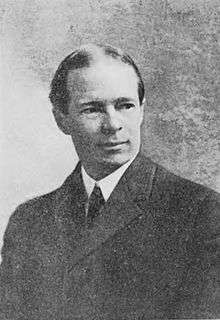Henry Chandler Cowles
| Henry Chandler Cowles | |
|---|---|
 | |
| Born |
February 27, 1869 Kensington, Connecticut, United States |
| Died | September 12, 1939 (aged 70) |
| Nationality | American |
| Fields | Botany |
| Institutions | University of Chicago |
| Alma mater |
University of Chicago Oberlin College |
| Thesis | The Ecological Relations of the Vegetation on the Sand Dunes of Lake Michigan (1898) |
| Doctoral advisor | John Merle Coulter |
| Doctoral students |
Victor Ernest Shelford William Skinner Cooper Paul Sears |
| Known for | Ecological succession |
| Spouse | Elizabeth Waller[1] |
| Children | Harriet[1] |

Henry Chandler Cowles (February 27, 1869 – September 12, 1939) was an American botanist and ecological pioneer (see History of ecology). A professor at the University of Chicago,[2] he studied ecological succession in the Indiana Dunes of Northwest Indiana.[3][4] This led to efforts to preserve the Indiana Dunes.[3][5] One of Cowles' students, O. D. Frank continued his research.[6]
Life and work
Born in Kensington, Connecticut, Cowles attended Oberlin College in Ohio. He studied at the University of Chicago with the plant taxonomist John M. Coulter and the geologist Thomas Chrowder Chamberlin as main teachers. He obtained his Ph.D. in 1898 for his study of vegetation succession on the Lake Michigan sand dunes. The inspiration to these studies came from reading Plantesamfund by the Danish botanist and pioneer ecologist Eugen Warming.[7][8] The translation of Warming's term into English as "Oecology" led to Cowles becoming one of the primary popularizers of the term ecology in the United States. Cowles studied Danish to be able to read the original[9] and later (1905) visited Warming in Copenhagen. Cowles was one of the founding members of the Ecological Society of America.[10]
Cowles married Elizabeth Waller in 1900, and their daughter Harriet was born in 1912.[1]
Legacy
One of Cowles's field study locations is now named Cowles Bog in his honor; Cowles Bog and nearby dune locations were later preserved for the public as part of the Indiana Dunes National Lakeshore. Cowles Bog is located off Shore Drive in Dune Acres, Indiana.
Among Cowles's students who advanced American ecology were Victor E. Shelford, William Skinner Cooper, Paul B. Sears, George Damon Fuller, Walter P. Cottam, Arthur G. Vestal and May Theilgaard Watts.[11] Cowles also served as a special field assistant of the United States Geological Survey.
Works
His publications include:
- Ecological Relations of the Vegetation on the Sand Dunes of Lake Michigan (1899)
- Text-Book of Botany (1910)
- Plant Societies of Chicago and Vicinity (1901)
See also
References
- 1 2 3 "Guide to the Henry C. Cowles Collectioncirca 1860s-1985". University of Chicago Library. Retrieved June 11, 2015.
- ↑ "Ecology and the American Environment". Library of Congress. Retrieved 25 June 2014.
- 1 2 Smith, S. & Mark, S. (2009). The Historical Roots of the Nature Conservancy in the Northwest Indiana/Chicagoland Region: From Science to Preservation. The South Shore Journal, 3.
- ↑ Schons, Mary. "Henry Chandler Cowles". National Geographic. Retrieved 25 June 2014.
- ↑ Smith, S. & Mark, S. (2006). Alice Gray, Dorothy Buell, and Naomi Svihla: Preservationists of Ogden Dunes. The South Shore Journal, 1.
- ↑ Smith, S. & Mark, S. (2007). The cultural impact of a museum in a small community: The Hour Glass of Ogden Dunes. The South Shore Journal, 2.
- ↑ A Letter from Henry A. Gleason, written 1952, printed in Brittonia 39: 2 (1987), pp. 205-209.
- ↑ Prytz, S. (1984) Warming – botaniker og rejsende. Lynge, Bogan; p. 127 quotes a letter from Cowles to Warming: "The reading of it (i.e. Plantesamfund) in the summer of 1896 turned the current of my life, which is now devoted to ecology".
- ↑ Cassidy, V.M. (2007) Henry Chandler Cowles – pioneer ecologist. Kedzie Sigel Press, Chicago.
- ↑ ESA history
- ↑ Sprugel DG (1980) A 'pedagogical genealogy' of American plant ecologists. Bulletin ESA 64: 197-200
- ↑ IPNI. Cowles.